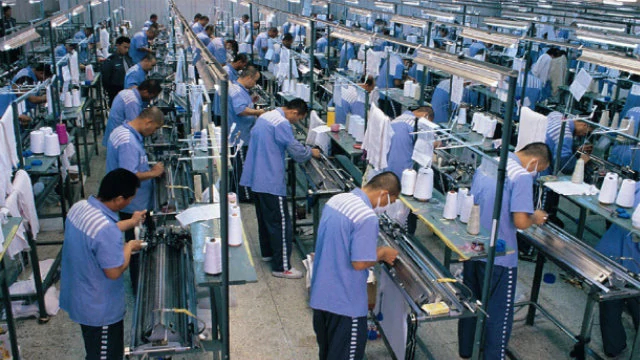Members of The Church of Almighty God share their experience manufacturing goods for foreign companies while serving time in prison for their faith.
by Lu An

Factories and workshops have been built in almost every prison in China, where inmates make products for local and foreign markets. Moreover, prisons compete among themselves, which results in unbearably long hours for inmates subjected to forced labor and even harsher oppression.
According to former inmates, work conditions in prison factories are below any reasonable standards, and barely any medical care is offered to workers. Without these additional costs and because Chinese intermediary companies provide raw materials for production, prisons make hefty profits only having to spend money on utilities and food for the forced labor workforce. However, these profits come at the price of inmates’ health, and sometimes even their lives. While denouncing human rights abuses in China, many consumers in the West may be using goods made by tortured and exploited prisoners.
Hiding ties to foreign companies behind Chinese intermediaries
A member of The Church of Almighty God (CAG), in her 30s, told Bitter Winter that the plant in the prison where she had served time for practicing her faith gets many orders because of low production costs. Companies from Hebei, Guangdong, Jiangsu, and other provinces have had long-standing business relationships with the prison. According to her, foreign companies are also among the prison’s clients, even though the administration tries to hide this fact.
“Clothes for Europeans and Americans are of different style and are usually larger in size, clearly not made for the Chinese market,” the believer explained. She added that the garments she had to make in prison didn’t have labels most of the time, but they sometimes had tags with prices in euros and were marked “Made in China.”
“Quality supervisors in the factory occasionally told us that every manufacturing process should be double-checked because of foreign clients’ strict requirements,” the woman continued. “Production for foreign companies often came to a halt because of quality problems. When this happened, the prison had to give feedback about the issues to the Chinese companies who had brought these foreign clients. These intermediaries, not the prison administration, were in direct contact with the foreigners.”
The factory not only made clothes but also lighting fixtures, boxes for packaging, and handbags. Many of these products were made for export. Production quotas increased continuously, and supervising guards who ensured that they were met would be awarded bonuses. “We all sighed deeply every time we were given new staggering quotas,” the CAG member said. “A ditty circulated in the prison: ‘since officers want bonuses, prisoners should work overtime.’”
Motivated by profit, prisons exploit inmates as slaves
Another recently released CAG member, also in her 30s, who has served time in central China, told Bitter Winter that new orders for the plant in her prison were coming continuously every month. All because of the low production costs. She remembered that the plant warehouse was often full, and materials were kept in the prison’s basketball hall, sometimes packed to its full capacity.
Prisoners were assigned high quotas and often had to work more than 13 hours every day. When there were many orders, they sometimes were only allowed three hours of rest before returning to work.
The woman was once given a daily quota to make 1,300 collars. She passed out from exhaustion one day and hit her head on an iron container. She was forced to resume her work after a short visit to the prison clinic to bandage the bleeding cut.
“It is not unusual for prisoners to faint in workshops,” the woman added. “In two extreme cases, a prisoner fell to the ground while working and died immediately, and the other suddenly collapsed and died when eating in a cafeteria. The prison administration issued a generic statement that they had died from sudden illness, to prevent prisoners from discussing the cases. They treat prisoners like ants whose lives don’t matter.”
To improve work efficiency for more profits, the prison continuously introduced new methods to control and punish working inmates. “Anyone who chatted or looked around while working could be beaten, tortured, forced to copy prison rules as punishment, or reprimanded in front of other inmates,” the believer explained. “Points were deducted for each ‘misdemeanor,’ meaning that prisoners had fewer chances their sentences could be reduced. Even the number of times or duration of using the toilet were also restricted.”
Mealtimes were limited to five minutes, and inmates often burned their mouths with hot food. Disproportionate to heavy labor, the food was terrible and not nourishing: porridge, pickles, steamed buns, and watery vegetable soup. Those who complained were brutally beaten, sometimes resulting in long-lasting injuries. The believer said that some inmates attempted suicide, unable to continue living in these unbearable conditions.
After six years in prison, the woman developed rheumatism, a cervical spine disease, and other ailments that commonly affect most inmates subjected to prolonged forced labor. Her pre-existing heart condition has also deteriorated, and she continues to have chronic headaches.
Several former inmates at a prison that runs a clothes-making plant told Bitter Winter that since workshops were poorly ventilated, the dust from materials was floating everywhere, workers inhaling it into their lungs. It was cold in the winter and hot in the summer. As a result, many inmates developed lung diseases, while others suffered severe backaches from working in uncomfortable positions for a long time without breaks.
Source: Bitter Winter



